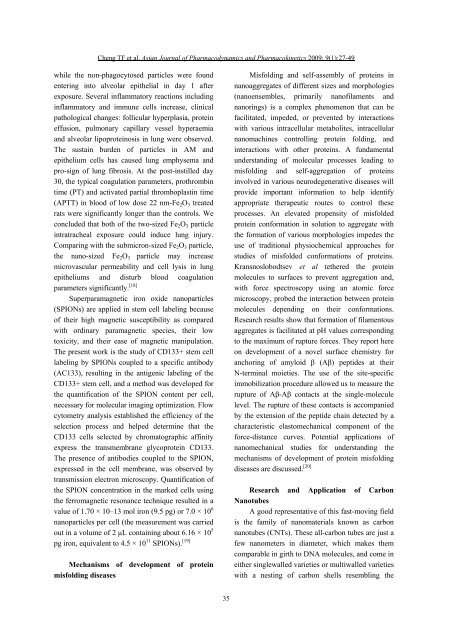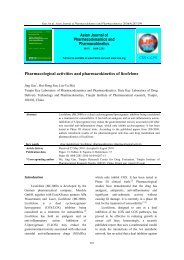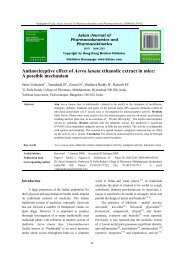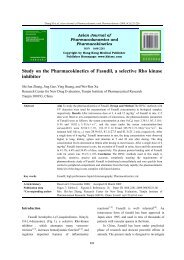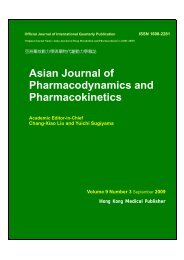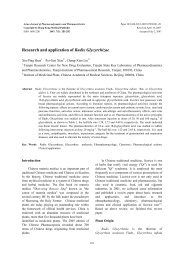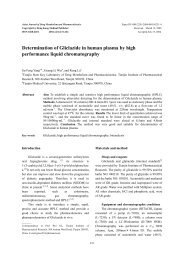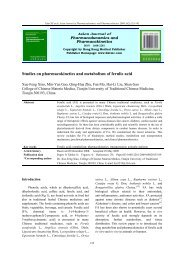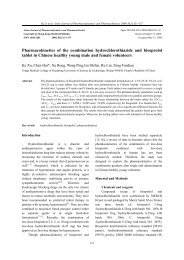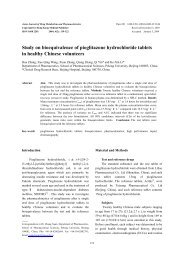Asian Journal of Pharmacodynamics and Pharmacokinetics
Asian Journal of Pharmacodynamics and Pharmacokinetics
Asian Journal of Pharmacodynamics and Pharmacokinetics
Create successful ePaper yourself
Turn your PDF publications into a flip-book with our unique Google optimized e-Paper software.
Cheng TF et al. <strong>Asian</strong> <strong>Journal</strong> <strong>of</strong> <strong>Pharmacodynamics</strong> <strong>and</strong> <strong>Pharmacokinetics</strong> 2009; 9(1):27-49<br />
while the non-phagocytosed particles were found<br />
entering into alveolar epithelial in day 1 after<br />
exposure. Several inflammatory reactions including<br />
inflammatory <strong>and</strong> immune cells increase, clinical<br />
pathological changes: follicular hyperplasia, protein<br />
effusion, pulmonary capillary vessel hyperaemia<br />
<strong>and</strong> alveolar lipoproteinosis in lung were observed.<br />
The sustain burden <strong>of</strong> particles in AM <strong>and</strong><br />
epithelium cells has caused lung emphysema <strong>and</strong><br />
pro-sign <strong>of</strong> lung fibrosis. At the post-instilled day<br />
30, the typical coagulation parameters, prothrombin<br />
time (PT) <strong>and</strong> activated partial thromboplastin time<br />
(APTT) in blood <strong>of</strong> low dose 22 nm-Fe 2 O 3 treated<br />
rats were significantly longer than the controls. We<br />
concluded that both <strong>of</strong> the two-sized Fe 2 O 3 particle<br />
intratracheal exposure could induce lung injury.<br />
Comparing with the submicron-sized Fe 2 O 3 particle,<br />
the nano-sized Fe 2 O 3 particle may increase<br />
microvascular permeability <strong>and</strong> cell lysis in lung<br />
epitheliums <strong>and</strong> disturb blood coagulation<br />
parameters significantly. [18]<br />
Superparamagnetic iron oxide nanoparticles<br />
(SPIONs) are applied in stem cell labeling because<br />
<strong>of</strong> their high magnetic susceptibility as compared<br />
with ordinary paramagnetic species, their low<br />
toxicity, <strong>and</strong> their ease <strong>of</strong> magnetic manipulation.<br />
The present work is the study <strong>of</strong> CD133+ stem cell<br />
labeling by SPIONs coupled to a specific antibody<br />
(AC133), resulting in the antigenic labeling <strong>of</strong> the<br />
CD133+ stem cell, <strong>and</strong> a method was developed for<br />
the quantification <strong>of</strong> the SPION content per cell,<br />
necessary for molecular imaging optimization. Flow<br />
cytometry analysis established the efficiency <strong>of</strong> the<br />
selection process <strong>and</strong> helped determine that the<br />
CD133 cells selected by chromatographic affinity<br />
express the transmembrane glycoprotein CD133.<br />
The presence <strong>of</strong> antibodies coupled to the SPION,<br />
expressed in the cell membrane, was observed by<br />
transmission electron microscopy. Quantification <strong>of</strong><br />
the SPION concentration in the marked cells using<br />
the ferromagnetic resonance technique resulted in a<br />
value <strong>of</strong> 1.70 × 10–13 mol iron (9.5 pg) or 7.0 × 10 6<br />
nanoparticles per cell (the measurement was carried<br />
out in a volume <strong>of</strong> 2 µL containing about 6.16 × 10 5<br />
pg iron, equivalent to 4.5 × 10 11 SPIONs). [19]<br />
Mechanisms <strong>of</strong> development <strong>of</strong> protein<br />
misfolding diseases<br />
Misfolding <strong>and</strong> self-assembly <strong>of</strong> proteins in<br />
nanoaggregates <strong>of</strong> different sizes <strong>and</strong> morphologies<br />
(nanoensembles, primarily nan<strong>of</strong>ilaments <strong>and</strong><br />
nanorings) is a complex phenomenon that can be<br />
facilitated, impeded, or prevented by interactions<br />
with various intracellular metabolites, intracellular<br />
nanomachines controlling protein folding, <strong>and</strong><br />
interactions with other proteins. A fundamental<br />
underst<strong>and</strong>ing <strong>of</strong> molecular processes leading to<br />
misfolding <strong>and</strong> self-aggregation <strong>of</strong> proteins<br />
involved in various neurodegenerative diseases will<br />
provide important information to help identify<br />
appropriate therapeutic routes to control these<br />
processes. An elevated propensity <strong>of</strong> misfolded<br />
protein conformation in solution to aggregate with<br />
the formation <strong>of</strong> various morphologies impedes the<br />
use <strong>of</strong> traditional physiochemical approaches for<br />
studies <strong>of</strong> misfolded conformations <strong>of</strong> proteins.<br />
Kransnoslobodtsev et al tethered the protein<br />
molecules to surfaces to prevent aggregation <strong>and</strong>,<br />
with force spectroscopy using an atomic force<br />
microscopy, probed the interaction between protein<br />
molecules depending on their conformations.<br />
Research results show that formation <strong>of</strong> filamentous<br />
aggregates is facilitated at pH values corresponding<br />
to the maximum <strong>of</strong> rupture forces. They report here<br />
on development <strong>of</strong> a novel surface chemistry for<br />
anchoring <strong>of</strong> amyloid β (Aβ) peptides at their<br />
N-terminal moieties. The use <strong>of</strong> the site-specific<br />
immobilization procedure allowed us to measure the<br />
rupture <strong>of</strong> Aβ-Aβ contacts at the single-molecule<br />
level. The rupture <strong>of</strong> these contacts is accompanied<br />
by the extension <strong>of</strong> the peptide chain detected by a<br />
characteristic elastomechanical component <strong>of</strong> the<br />
force-distance curves. Potential applications <strong>of</strong><br />
nanomechanical studies for underst<strong>and</strong>ing the<br />
mechanisms <strong>of</strong> development <strong>of</strong> protein misfolding<br />
diseases are discussed. [20]<br />
Research <strong>and</strong> Application <strong>of</strong> Carbon<br />
Nanotubes<br />
A good representative <strong>of</strong> this fast-moving field<br />
is the family <strong>of</strong> nanomaterials known as carbon<br />
nanotubes (CNTs). These all-carbon tubes are just a<br />
few nanometers in diameter, which makes them<br />
comparable in girth to DNA molecules, <strong>and</strong> come in<br />
either singlewalled varieties or multiwalled varieties<br />
with a nesting <strong>of</strong> carbon shells resembling the<br />
35


